The Average PTO in the US and Other PTO Statistics for 2025
The majority of employees believe having paid time off is important. Still, many of them don’t use up their available time off during the year.
So, why do workers refrain from using PTO? Are companies doing enough to encourage their employees to take time off?
Find answers to these questions and many others including:
- What is the average PTO in USA,
- How many vacation days in USA is the norm, and
- How does the US PTO usage and access compare to other countries.

PTO statistics: 10 most important stats
PTO, or the time you take off from work without any loss of pay, is a common benefit that contributes to millions of workers around the world feeling valued and appreciated.
Let's take a look at the 10 most important PTO statistics to see whether the numbers reflect that:
- 62% of people think having paid time off is extremely important.
- 88% of full-time employees had access to paid vacation in 2024.
- 46% of workers don’t use up all of their PTO during the year.
- 68% of employees work while on vacation.
- 52% of US workers worry about work during vacation.
- 23.5%of US workers don’t receive compensation for unused PTO.
- The average vacation time for civilian and private industry employees is 11 days after 1 year of service.
- 96% of employees in the management, business, and finance sectors have access to paid leave.
- Most satisfied workers take 15 days of PTO on average.
- Most European countries offer at least 20 days of PTO.
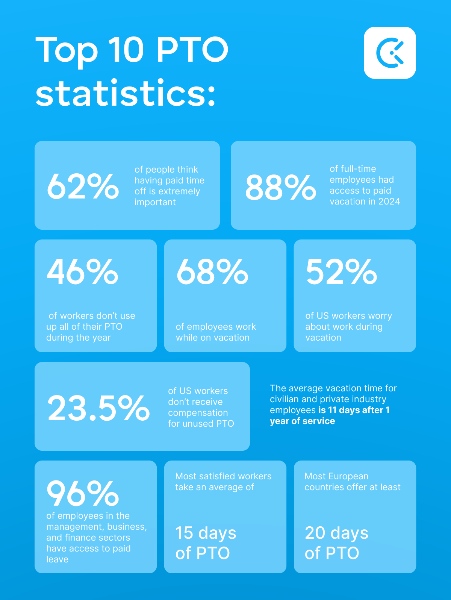
How much PTO does the average American get?
The federal law does not require employers to offer any paid time off to their employees. Therefore, PTO is a matter of employment contract.
Still, along with the details agreed on in contracts, the average PTO in USA depends on various factors, with the most important ones being:
- The type of service (civilian, private industry, and state or local government employment), and
- Years of service.
Moreover, the type of PTO plan (consolidated or separate leave policies) greatly impacts the number of days off employees have available per year.
A consolidated leave plan incorporates all types of leave within one policy. On the contrary, some employers offer separate leave policies for different types of leave, such as:
- Sick leave,
- Personal time off,
- Vacation leave, and
- Family and medical leave.
Here’s the average PTO in USA depending on the type of service and PTO plan employees have.
The average PTO in USA for consolidated leave plans
According to the official US Bureau of Labor of Statistics numbers, the average paid time off in the US for civilian and private industry employees with consolidated leave plans per year is:
- 14 days after 1 year of employment,
- 18 days after 5 years of service,
- 20 days after 10 years of work, and
- 23 days after 20 years of service.
Furthermore, the average PTO and sick days in USA for government workers with consolidated leave plans per year is:
- 18 days after 1 year,
- 21 days after 5 years,
- 24 days after 10 years, and
- 27 days after 20 years.
The average PTO and sick days in the USA for separate leave plans
According to the US Bureau of Labor numbers, the average civilian employee with a separate sick leave plan gets a total of 8 paid sick days per year, regardless of years of service.
An average private industry worker has 7 paid sick days per year available, no matter how long they’ve been employed.
On the other hand, the average number of paid sick days for government workers highly depends on the years of service. Government employees receive an average of:
- 11 sick days per year after 1 year of employment, and
- 12 sick days per year after 5 years of employment.
🎓 Paid Sick Leave Laws by State Guide for 2024
The average vacation time in the US for separate leave plans
The average number of vacation days per year (as a separate leave plan) also depends on the type of service and years of employment.
The US Bureau of Labor Statistics report shows how many days of vacation per year private industry employees typically get:
- 11 days per year after 1 year of service,
- 15 days per year after 5 years of service,
- 18 days per year after 18 years of employment, and
- 20 days per year after 20 years of service.
How many vacation days in USA per year you get as a government employee also depends on the years of service. The average number of vacation days per year for state or local government workers is:
- 13 days per year after 1 year,
- 16 days per year after 5 years,
- 19 days per year after 10 years, and
- 22 days per year after 20 years of service.
What percentage of Americans have PTO? Paid leave access statistics
Let’s see the percentage of private-sector employees, civilian and government workers who had access to paid vacation, sick days, and holidays.
Access to paid vacation
The latest US Bureau of Labor numbers tell us that 80% of private-sector employees had paid vacation available in 2024. Furthermore, 77% of civilian workers were offered paid vacation that same year.
The number is much lower for government workers, as only 60% of government employees had paid vacation leave available.
Access to paid sick days
Paid sick leave is a crucial government benefit, as 92% of government employees had access to paid sick days.
Moreover, 81% of civilian workers and 79% of private-sector employees had paid sick leave available in 2024.
Access to paid holidays
The same US Bureau of Labor numbers show us that 79% of civilian workers had access to paid holidays.
On the other hand, 81% of private industry workers had access to paid holidays, which is significantly higher compared to 68% of government employees with the same benefit.
Let's look into paid leave access statistics for different categories of workers in more detail.
Employees in larger companies receive more PTO benefits
Data from the BLS's 2024 Employee Benefits Survey shows that employees of larger companies are more likely to have access to PTO benefits.
This table shows the percentage of workers who have access to PTO benefits depending on the size of the business they work at:
| Company size | Vacation leave | Sick leave | Holiday leave |
|---|---|---|---|
| 1-49 employees | 70% | 72% | 73% |
| 50-99 employees | 72% | 76% | 69% |
| 100-499 employees | 84% | 88% | 87% |
| 500+ employees | 82% | 90% | 86% |
Full-time workers are more likely to have access to PTO benefits
The same Employee Benefits survey showed that full-time employees are more likely to receive PTO benefits when compared to part-time workers.
🎓 Part-time vs. Full-time Employment: Understanding the Difference
Here’s the percentage of workers with access to vacation, sick, and holiday leave (the survey offers no data for personal leaves), depending on the type of employment:
| Employment type | Vacation leave | Sick leave | Holiday leave |
|---|---|---|---|
| Full-time | 88% | 89% | 88% |
| Part-time | 38% | 55% | 48% |
Union employees are more likely to receive PTO benefits
Union workers are more likely to receive PTO benefits, the same Employee Benefits survey shows.
Take a look at the table that shows the percentage of union and non-union workers with access to vacation, sick, and holiday leave:
| Bargaining status | Vacation leave | Sick leave | Holiday leave |
|---|---|---|---|
| Union | 75% | 91% | 82% |
| Non-union | 77% | 79% | 79% |
Higher-earning workers receive more benefits
The said Employee Benefits survey also showcased the discrepancy between higher and lower-earning workers in civilian and private industry sectors. The highest-earning workers in these sectors are more likely to receive benefits such as paid sick leave, paid vacation, and paid holidays.
On the other hand, government employees have access to similar benefits regardless of their earnings.
The survey divided employees’ wages into 4 categories, based on the average wage for different occupations:
- The lowest-earning 25%,
- The second 25%,
- The third 25%, and
- The highest-earning 25%.
The table shows paid vacation time vs paid holidays as well as sick leave access based on each category, for civilian and private-industry sectors:
| Earnings | Vacation leave | Sick leave | Holiday leave |
|---|---|---|---|
| Lowest-earning occupations (25%) | 56% | 60% | 61% |
| Second lowest-earning occupations (25%) | 83% | 84% | 84% |
| Third lowest-earning occupations (25%) | 90% | 88% | 90% |
| Highest-earning occupations (25%) | 82% | 95% | 85% |
Access to PTO isn’t the same in every industry
According to the US Bureau of Labor Statistics data, not all employees have access to paid leave benefits. The numbers vary greatly between industries.
Here’s the percentage of workers who had access to paid leave (sick leave, vacation, and holidays):
| Industry | Civilian | Private | Government |
|---|---|---|---|
| Management, business, and finance | 95.3% | 96% | No data |
| Installation, maintenance, and repair | 88.3% | 87.3% | No data |
| Office and administration | 88.3% | 88% | 89% |
| Production and transportation | 84.3% | 84.3% | 76.6% |
| Construction, extraction, farming, fishing, and forestry | 74% | 72.3% | No data |
| Sales | 72% | 72.3% | No data |
| Education | 62.3% | 75.6 | 58.3% |
Manage your time off with Clockify
Employees in the Western USA are most likely to have PTO
The same US Bureau of Labor Statistics research shows differences in paid leave access based on employees’ region. Take a look at the percentages of employees who had access to paid sick leave, paid vacation, and paid holidays:
- Western US — 82.6%,
- Northeastern US — 81%,
- Southern US — 75.6%, and
- Midwestern US — 78.3%.
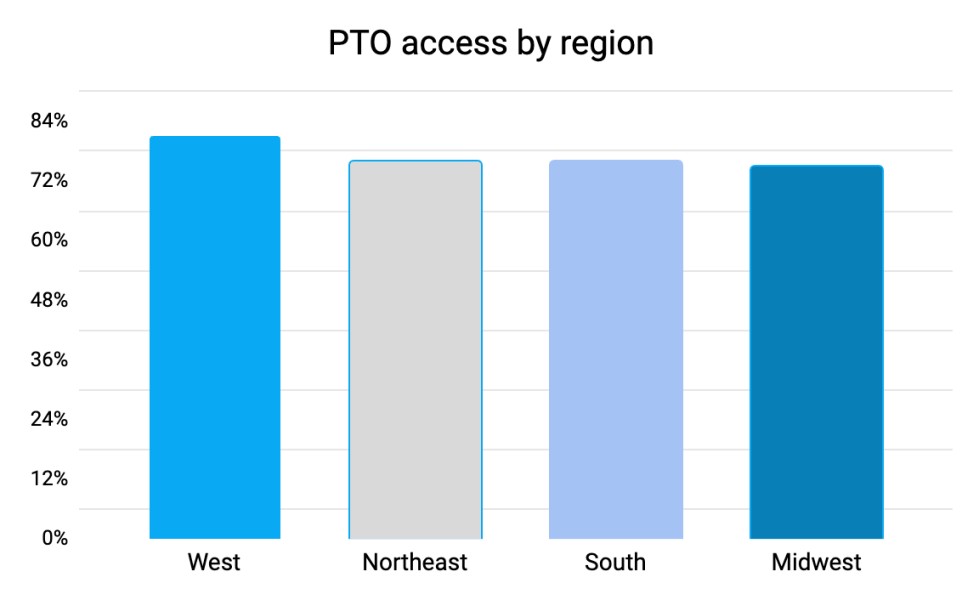
How employees use their PTO: Statistics on PTO usage in the US
Have you ever wondered how much employees value having paid time off? What about how often PTO is actually used in the United States?
Learn more about the typical PTO usage in the US as well as how work stress affects US vacation time.
62% of people think having paid time off is extremely important
A recent survey by the Pew Research Center found that 62% of US workers believe it’s “extremely important” to have paid time off for:
- Vacations,
- Minor illnesses, and
- Routine doctor’s appointments.
Out of this number, 27% believe paid time off for these circumstances is “very important.”
46% of workers don’t use up all of their time off
The same survey by the Pew Research Center showed that nearly half of US employees (46%) don’t use up all of their available time off.
On the other hand, 48% of people use all of their available days off. The survey doesn't mention the preferences of the remaining 6% of participants.
The survey results also show that employees with higher education and upper-income employees tend to use less time off than offered.
43% of workers don’t use their PTO due to heavy workload
Heavy workload is among the top reasons why employees don’t use their PTO, the International Foundation survey reports.
Here are other reasons why workers don’t take paid time off:
- 23.8% don’t use their PTO due to the lack of adequate staffing,
- 13.1% have difficulties taking time off due to the need for PTO coordination with other employees, and
- 6.9% prefer to take cash payout for unused PTO.
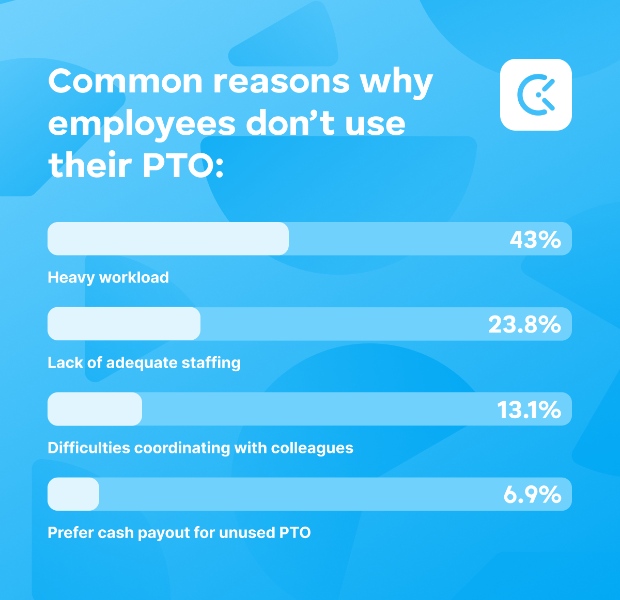
More than 8% of employees don’t feel supported to take time off
Companies' behavior can discourage employees from taking their earned vacation. The said International Foundation survey showed that some workers don’t feel supported to take PTO.
Here’s what employees reported regarding the lack of support:
- 3.8% claim taking PTO isn’t supported by their manager,
- 3.1% blame organizational culture and stigma for unused PTO, and
- 1.3% report that the company leadership doesn't support using PTO.
56% of employers cap unused time off
Companies came up with different ways to encourage time off. According to WorldatWork research, more than half of organizations (56%) cap the amount of time off workers are allowed to bank.
Furthermore, 26% of surveyed employees have a “use-it-or-lose-it” policy. This policy means that any unused time off doesn’t roll over to the following year or pay period. Instead, the accumulated PTO expires.
In addition, 5% of organizations introduced the minimum number of days off an employee has to take during a year.
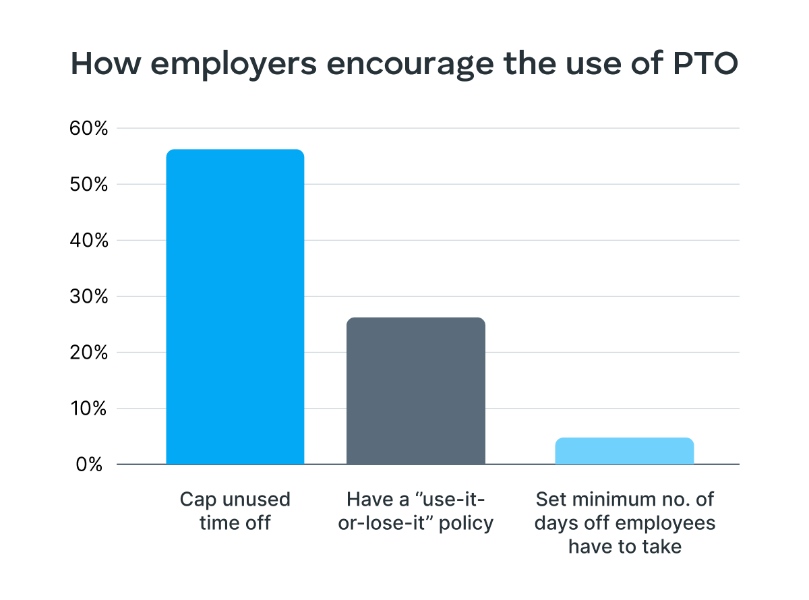
Most satisfied workers take an average of 15 days of PTO
According to CalendarLabs' recent survey, employees who are most satisfied with their jobs took 15 days of PTO in 2023.
This survey also showed that, in general, remote employees take an average of 14 PTO days annually. On the other hand, on-site workers need 15 days off on average.
60% of employers struggle with recruiting new employees, partially due to PTO
AbsenceSoft’s Leave and Workplace Accommodations Forecast report explored the value of paid leave policies to employees.
The survey showed that a lack of paid leave would deter job seekers from applying for a position. Thus, offering paid leave is a smart way to attract top talent.
51% of organizations added paid mental health days to their PTO policies
Organizations are beginning to understand the importance of incorporating different types of paid leave into their policies.
The same AbsenceSoft report showed that many organizations have added paid mental health days to their PTO policies. Organizations also incorporated other PTO policies:
- 54% introduced paid parental leave,
- 49% incorporated paid bereavement leave, and
- 37% added paid caregiver leave to their PTO policy.
🎓 Mental Health Leave of Absence — Guide for 2024
Employees are now 42% more likely to take sick days
Gusto compared the number of sick days workers have been taking in recent years. According to their recent findings, the number of sick days taken in 2023 is 42% higher than in 2019.
What’s more, the number of hours of sick time employees took has increased by 15%. It now amounts to an average of 15.5 hours per year.
20% of managers encourage sick employees to come to work
A ResumeBuilder survey explored managers’ views on employees taking sick leave.
It showed that an alarming number of managers discourage workers from resting while sick. What’s more, 27% of them believe that the culture of coming to work sick contributes to employee productivity.
Moreover, 24% of managers believe workers who take sick time exaggerate or lie about their illness. As many as 11% of survey participants even admitted to “sick shaming” their employees.
32% of USA employees skip vacation for 1 year or more
According to Expedia’s Annual Vacation Deprivation Report, 32% of Americans will skip their annual vacation.
Compared to 18% of global employees who skip annual holidays, Americans are significantly more likely to miss their time off. And even when on vacation, only 61% of employees actually prioritize relaxation.
52% of Americans worry about work during vacation
Vacation days in America aren’t as enjoyable as they should be. Based on the Survey by Radical Storage research, the majority of employees have work on their minds while on vacation, regardless of how many days of vacation per year they have.
Here’s how often employees worry about work during vacation:
- All the time — 15%,
- Most of the time — 37%,
- Sometimes — 39%, and
- Never — 9%.
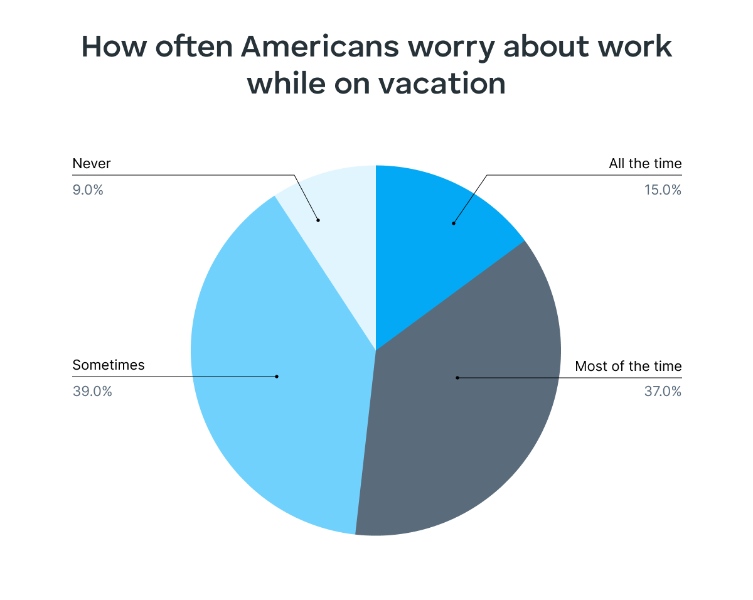
68% of employees work on vacation
A recent survey conducted by ELVTR showed that 68% of US and Canadian workers perform work tasks while on vacation.
For 27% of survey respondents, this reportedly isn't an issue as they love their jobs and don’t mind working on vacation.
On the other hand, 37% of survey participants feel as if they have to work since they have nobody to delegate their tasks to.
35% of workers feel they’re expected to work while on vacation
The same ELVTR survey also reports that 35% feel there is an expectation to work when they’re on vacation. Furthermore, 18% of workers claim their boss requires them to at least check their emails while on vacation.
Moreover, many employees receive work messages and calls during vacation:
- 28% of workers report receiving work emails,
- 25% of employees get text messages,
- 6% of workers are contacted via phone calls, and
- 2% of employees receive work-related social media messages.
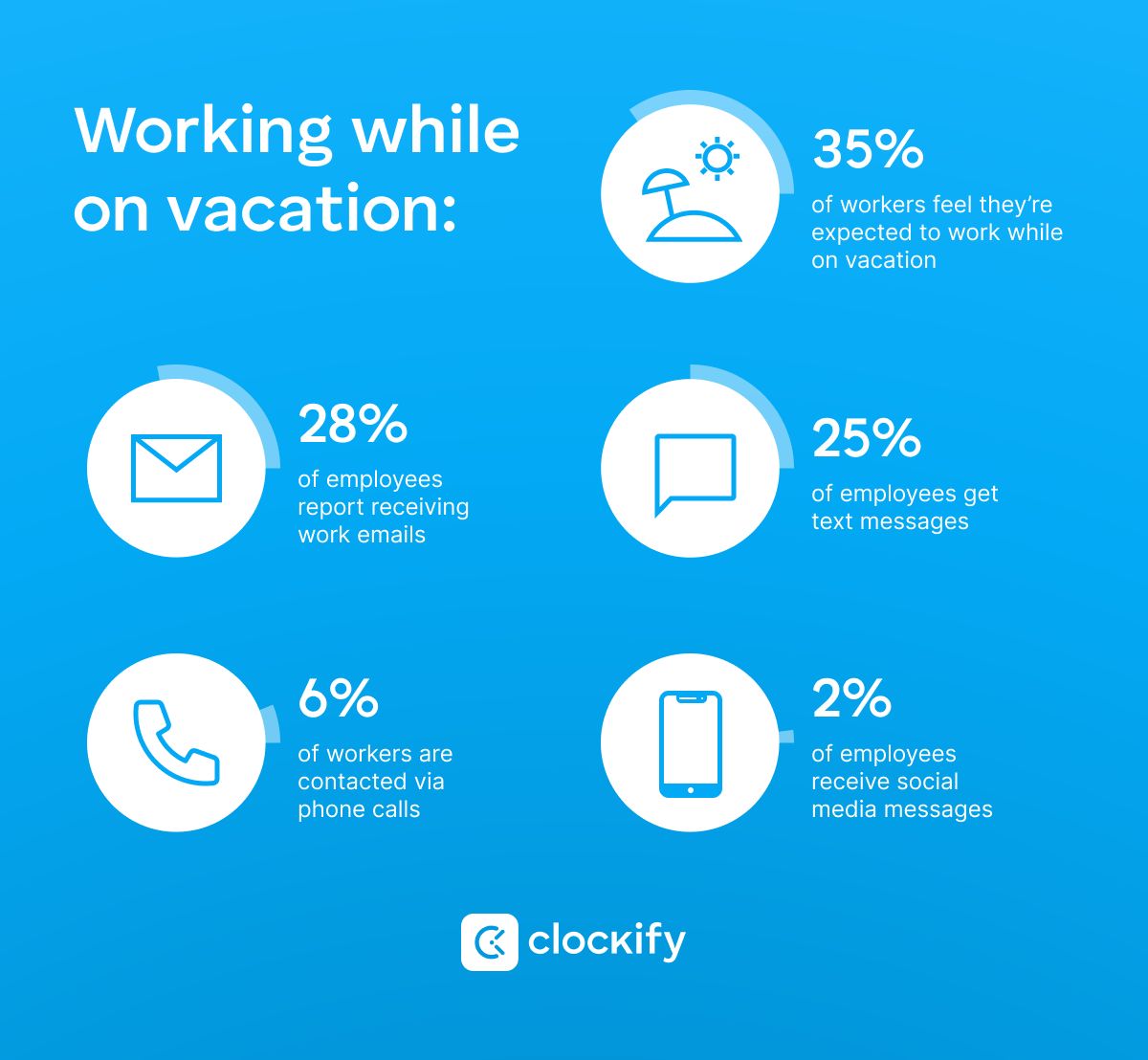
76% of organizations allow PTO rollover
The WorldatWork study also explored what happens to unused PTO.
Here are the common ways organizations handle unused time off:
- 76% allow PTO to roll over to the next year (transferring unused time to the next year),
- 50% let employees cash out the unused PTO, and
- 33% allow workers to donate unused time off to other employees.
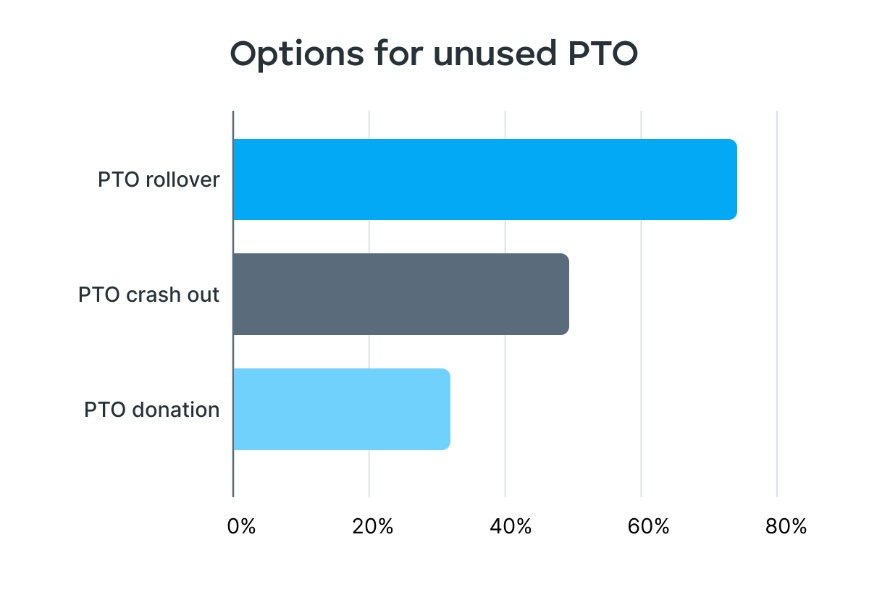
23.5% of workers don’t get paid for unused time off
The WorldatWork study we mentioned earlier reports that 23.5% of workers don’t get paid for unused banked PTO upon termination.
On the upside, 76.5% of workers get reimbursed for unused PTO. The numbers are higher for voluntary termination (82%) than for involuntary termination (71%).
For companies that offer separate vacation days, 83% of terminated employees get paid for unused vacation time.
The situation is different for unused sick days — only 6% of workers are reimbursed for sick days they didn’t use.
20% of the USA states require PTO payout upon termination
Only 10 states legally require PTO payout after termination. But, a staggering 82% allow companies to decide whether to pay for PTO depending on their employment agreement.
What PTO policy employees want to have?
According to the said International Foundation survey, the majority of employers (54.2%) offer separate vacation, personal, and sick time.
PTO bank (consolidated leave plans) comes in second (38.2%), while unlimited PTO is the third popular option (7.6%).
Create a PTO policy with Clockify
| PTO policy | Percentage of employers who offer this policy |
|---|---|
| Separate paid leave policies | 54.2% |
| PTO bank | 38.2% |
| Unlimited PTO | 7.6% |
But what kind of policy do employees want to have?
A recent Empower study on PTO asked employees about their PTO policies. Let’s take a look at the respondents’ answers.
51% of the employees schedule their PTO days around public holidays
This way, employees make the most out of their PTO by having more free days. Also, 32% of Americans use their PTO to head straight to destinations where they might retire.
26% of workers would apply for a lower-paying job to have unlimited PTO
Unlimited PTO is a must-have benefit for 26% of workers, and they would rather choose a lower salary than give it up.
Unlimited PTO allows workers to take as much time off as they need. There’s no cap on how much PTO they can take as long as their absence doesn’t affect their or their colleagues’ performance.
🎓 What is absenteeism? Causes and consequences
16% of workers wouldn’t accept a job without a 4-day workweek
The same Empower study states that 16% of workers would turn down a job offer if the company didn’t include the possibility of a 4-day workweek. The research found that 11% of employees would accept a pay cut of $1000 just to secure a 3-day weekend.
🎓 The Ultimate Guide to a Compressed Workweek
85% of employees claim that vacation increases their happiness
A staggering 85% of employees state that they notice increased levels of happiness after using a vacation. At the same time, 46% of employees would donate their PTO days to a colleague who needs them.
What is the average PTO around the world: Global PTO statistics
According to a paid leave analysis by Resume.io, these countries offer the most paid leave days a year (including paid holidays) to employees:
- Iran — 53 days,
- San Marino — 46 days,
- Yemen — 45 days,
- Andorra — 44 days,
- Bhutan — 44 days,
- Bahrain — 44 days,
- Togo — 43 days,
- Niger — 43 days,
- Madagascar — 43 days, and
- Monaco — 42 days.
Keep reading for more worldwide PTO statistics!
🎓 What are paid holidays and how do they work?
Paid vacation days by country in Europe
European countries have set a minimum requirement of 20 paid vacation days per year which have to be available to workers.
Still, the exact number of paid vacation days by country can differ. European countries with the most vacation days available are:
- France — 30 days,
- The UK and Moldova — 28 days,
- Luxemburg — 26 days, and
- Denmark, Sweden, and Austria — 25 days.
Canadian workers usually have 2 weeks of paid leave
The number of available paid days in Canada varies from province to province.
But in most cases, Canadian employees are offered a minimum of 2 weeks of paid leave after 1 year of employment. After 5 years, workers typically have one more week of paid leave available.
In the Saskatchewan province, employees get 3 weeks of leave after the first year of their employment.
Australians have 4 weeks of leave annually
In Australia, annual leave (also referred to as holiday pay) is available to both full-time and part-time workers.
Australian employees receive 4 weeks of paid leave for every year they work.
Some Asian countries’ minimum leave requirements go as low as 5 days
As specified by the Guide to employment law by Linklaters, Chinese workers have between 5 and 15 days off, depending on the length of service and how long they have been employed in the country.
Moreover, Japanese employees who worked at least 6 months for at least 80% of working days per year have 10 days of paid leave available.
What’s more, in India, workers can have from 15 to 21 days of leave available per year.
Create PTO policies and track employee time off with Clockify
PTO statistics show that a great number of Americans view PTO as one of the crucial job benefits.
Taking paid time off is essential for proper work-life balance and employee satisfaction. So, it’s important to create PTO policies that encourage workers to take time off.
However, many employers find tracking and reporting data on PTO programs complicated.
Thankfully, you can make this process much simpler by opting for a PTO & Vacation Tracker software such as Clockify. Clockify allows employers to easily create a time off policy for their company and choose whether the policy applies to all employees or specific departments.
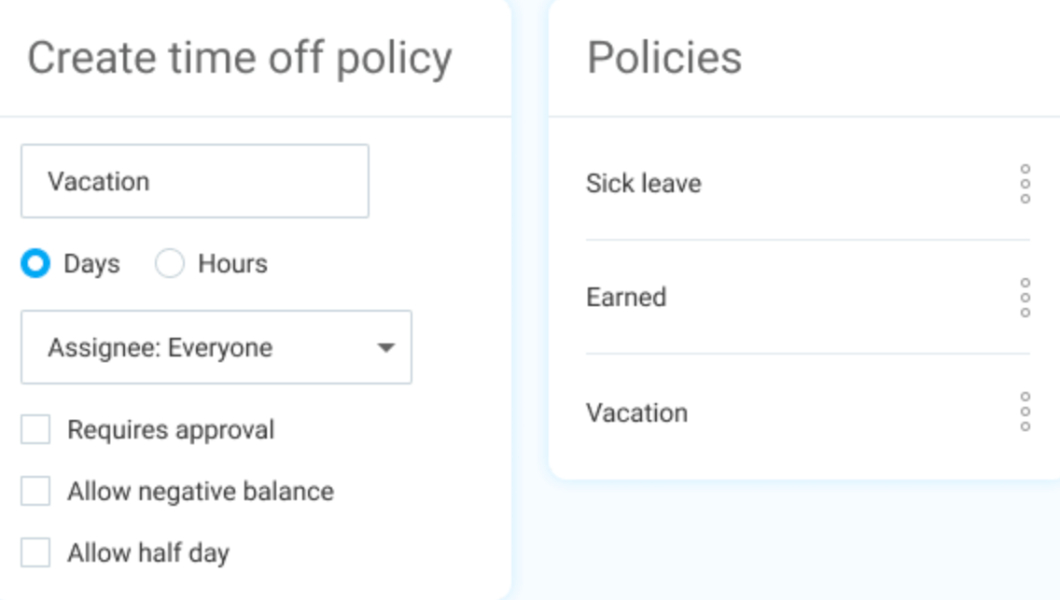
You can make a time off policy as specific as you want, as there are many options such as:
- Sick leave,
- Vacation,
- Sabbatical,
- Family leave,
- Half-day,
- Business trip, and
- National holiday, etc.
Workers can then request time off and wait for approval from their supervisor. All employees can have an overview of everybody’s time off, which makes tracking and managing absence and workload much easier.
Sources:
- 1 in 10 Managers “Sick Shame” Unwell Workers They Forced To Come into the Office. (2024). ResumeBuilder
- Additional leave entitlements for working parents. OECD Family Database
- America’s Alarming (Lack of) Work-Life Balance. (2024). ELVTR
- Annual Vacation and Vacation Pay. Government of Saskatchewan
- Bowen, T. (2023). Younger Workers Leading the Charge on Taking Sick Leave Post-Pandemic. Gusto
- Census Regions and Divisions of the United States. US Census Bureau
- DIVISION IV: Annual Vacations. Canada Labour Code.
- EBS Latest Numbers. US Bureau of Labor Statistics
- Employee Benefits Survey. US Bureau of Labor Statistics
- Employee Benefits Survey News Release. US Bureau of Labor Statistics
- Employees pay, leave and entitlements. (2023). Australian Government
- Guide to employment law in Asia. Linklaters
- Joblist. (2022). How Do Unlimited Vacation Policies Affect Employees? Over 1,000 Employees Weigh In
- Menasce Horowitz, J., Parker, K. (2023). How Americans View Their Jobs. Pew Research Center
- Paid Leave. US Department of Labor
- Paid leave benefits. US Department of Labor
- Paid Leave in the Workplace: 2024 Survey Report. (2024). International Foundation of Employee Benefit Plans
- Piva, G. (2024). Burnout Escapes: Vacations Due to Work Stress. Radical Storage
- Selected paid leave benefits: Access. US Department of Labor
- The 2024 Leave and Workplace Accommodations Forecast Report. (2024). AbsenceSoft
- The Time Off Report. (2023). CalendarLabs
- Time Well Spent. (2024). WorldatWork Total Rewards Association
- Towey, H. (2023). Forget summer Fridays: These 9 European countries guarantee workers at least 5 weeks of paid vacation per year. Insider
- Vacation Leave. US Department of Labor
- Van Rijswijk, L. (2023). Which country gets the most paid vacation days?. Resume.io